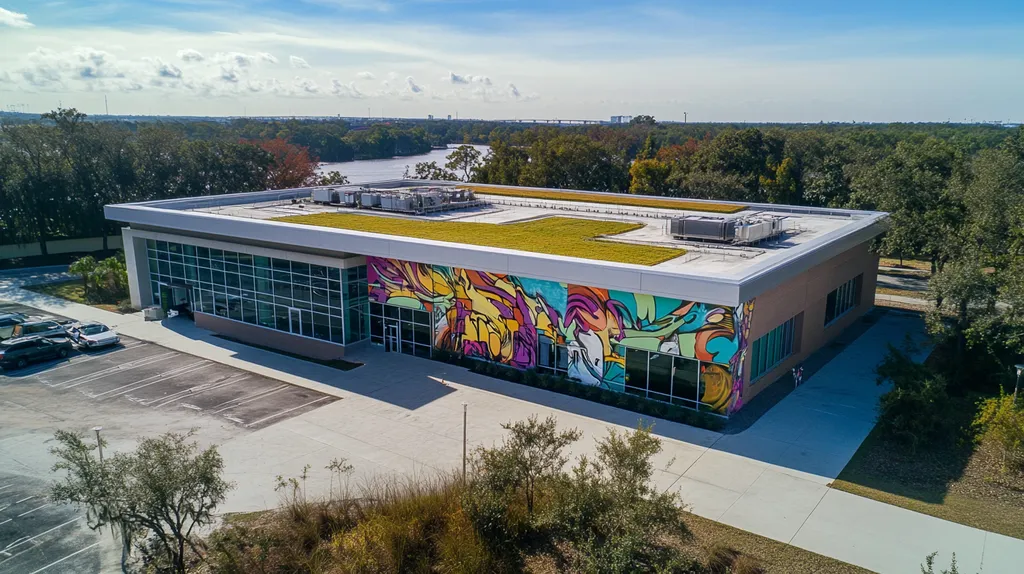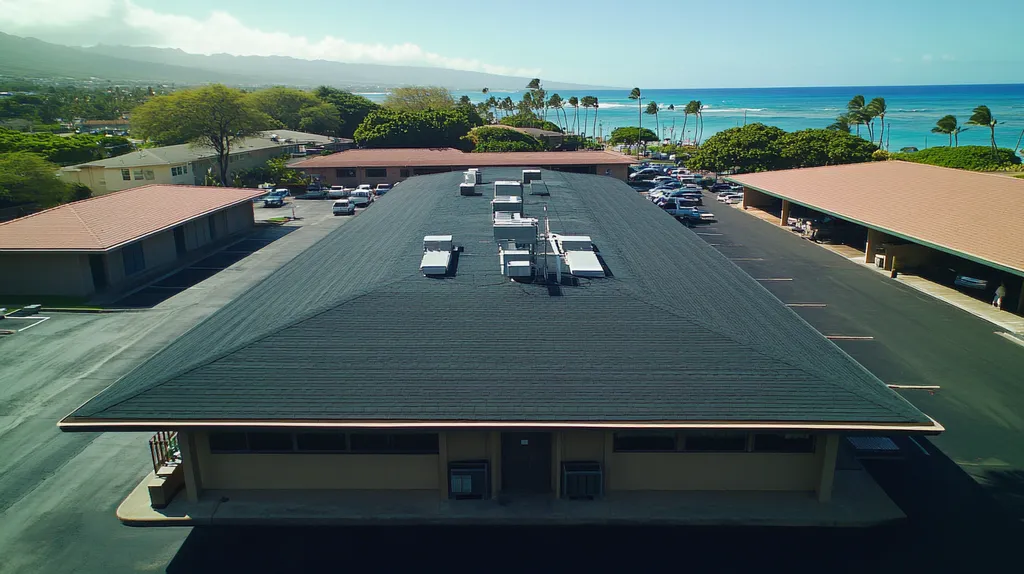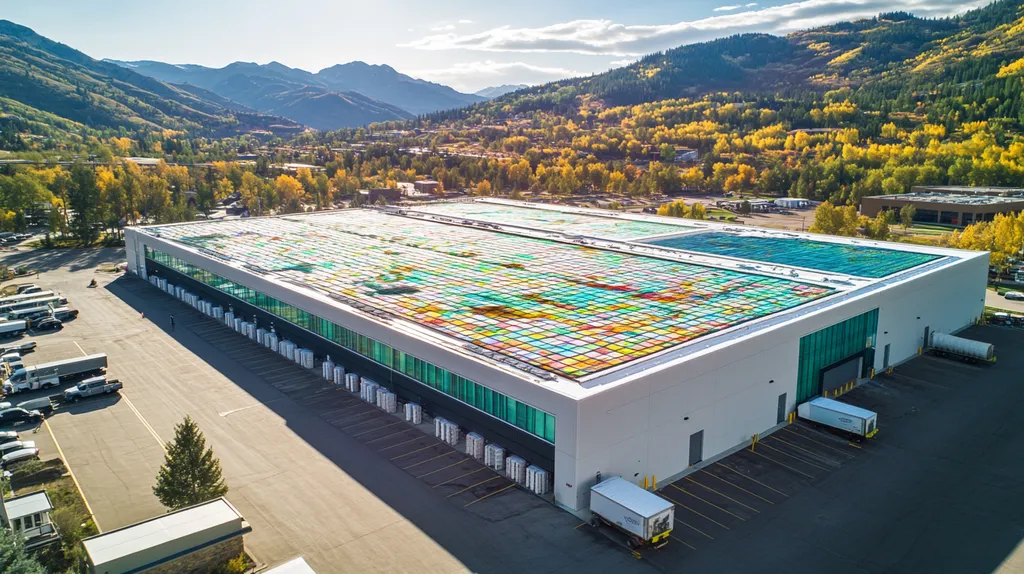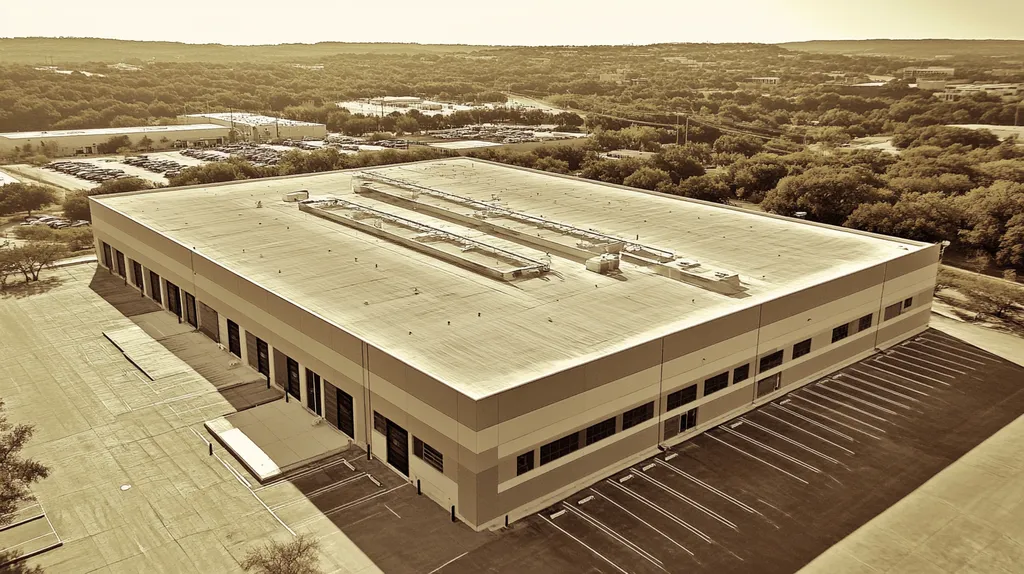Industrial roofing projects across the United States face mounting pressure as odor-related complaints surge by 47% annually, leading to project delays and diminished property values.
Traditional odor control methods struggle to meet increasingly strict environmental regulations while maintaining efficiency during roof installations.
This analysis examines systemic failures in current practices, identifies overlooked technological solutions, and presents data-driven evidence for alternative approaches that can revolutionize how the industry manages odor control.
SECTION 1: CURRENT PRACTICES
The industrial roofing industry is under pressure to deliver solutions that minimize disruptions, especially during installation. Ignoring odor issues can result in tenant complaints that lead to costly delays and damage to a property’s reputation. As the demand for odor control grows, companies must address potential health concerns and strive for improved standards in their roofing applications.
Common Odor Control Methods
Facility managers frequently use traditional odor control methods that depend on low-VOC (Volatile Organic Compounds) materials. Although these choices reduce strong odors compared to high-VOC materials, they do not eliminate them entirely. Some companies attempt to mask odors with chemical agents, providing only a temporary fix.
These conventional methods often miss the root causes of odor problems. Consequently, property owners still hear complaints from tenants, resulting in disruptions and operational challenges. The variable effectiveness of these methods limits roofing companies’ ability to meet client expectations consistently.
By adjusting current practices and embracing innovative technologies, the industry could significantly improve odor management. Continuing to rely on outdated techniques risks falling short of new environmental regulations and client demands.
Sticking with familiar methods can impede progress toward genuinely sustainable and odor-free roofing solutions, ultimately affecting relationships with all stakeholders involved.
Adhesive Application Techniques
Effective adhesive application techniques are essential for managing odors during roofing projects. Common methods include solvent-based and water-based adhesives. While solvent-based adhesives offer strong bonding, they also release prominent odors that can interfere with operations.
On the other hand, water-based adhesives produce far fewer odors but can be affected by temperature and moisture levels. This variability may compel contractors to opt for stronger-smelling adhesives, weighing the trade-off between adhesion strength and odor control.
Improved application techniques, such as spray or roller methods, can help limit odor release during the installation process. These techniques reduce the adhesive’s exposure to air, which in turn minimizes potential disturbances. However, effective execution requires adequate training for personnel.
As a result, refining adhesive application techniques is crucial for better odor management in the roofing industry. Property owners should promote these advancements to create safer, more comfortable working environments.
Ventilation System Integration
A robust ventilation system is critical for effective odor control during roofing applications. Proper ventilation can disperse odors before they infiltrate building interiors, which helps reduce complaints from occupants. Unfortunately, many properties do not have sufficient ventilation, complicating odor management during roofing activities.
Modern ventilation solutions, including portable exhaust systems and ambient air filtration units, can significantly alleviate odor issues. These systems actively remove airborne contaminants while preserving air quality indoors. However, initial installation demands time and investment, which may deter some property owners.
Furthermore, a well-designed ventilation system must be coordinated with roofing activities. This requires collaboration between roofing contractors and HVAC professionals to ensure smooth integration. Failure to achieve this synergy can result in inadequate performance and ongoing odor problems.
In summary, prioritizing the integration of ventilation systems during roofing projects is vital for minimizing odors and enhancing tenant satisfaction. Property owners should aim for comprehensive strategies that improve both odor control and overall building performance.
SECTION 2: SYSTEMIC ISSUES
The challenge of managing unpleasant odors during industrial roofing applications highlights systemic issues plaguing the industry. Poorly controlled odors can trigger tenant complaints, invite regulatory scrutiny, and harm a property’s reputation. Understanding the root causes of ineffective odor management is crucial, especially regarding the subjective nature of odor perception, fragmented regulatory frameworks, and insufficient measurement techniques. These interconnected factors profoundly impact decision-making for roofing stakeholders.
Subjective Nature of Odor Perception
Odor perception can vary widely among individuals, making it challenging to determine an acceptable threshold for various odors. While some may find the smells associated with industrial roofing adhesives acceptable, others may consider them intolerable. This variance complicates the assumption that the community and employees will universally accept these odors.
Environmental conditions, such as humidity and temperature, also play a significant role in how odors are perceived. These factors can lead to inconsistent complaints from tenants, making it difficult for property owners to gauge the impact of roofing operations on their business activities.
The absence of standardized metrics for measuring odor intensity further complicates the situation. Property managers often lack a clear understanding of the conditions affecting odor perception, hindering their ability to develop effective odor mitigation strategies. Addressing these subjective aspects is vital for advancing industrial roofing practices.
Ultimately, the industry must implement more standardized approaches to deal with these perception challenges. This shift would enhance the existing standards for odor control in roofing applications.
Regulatory Challenges and Gaps
Another significant hurdle in managing odors during industrial roofing projects is the often fragmented regulatory landscape. Many areas lack clear guidelines regarding acceptable odor levels during construction, resulting in confusion for contractors and property owners. The absence of such regulations can create safety risks and lead to community dissatisfaction.
Due to varying requirements across states and municipalities, roofing projects can face drastically different regulatory expectations. Some regions mandate detailed odor management plans, while others overlook the need for such precautions altogether. This inconsistency can impede effective odor control efforts and complicate compliance for roofing contractors.
Moreover, the lack of consistent enforcement outcomes means that even well-conceived odor management strategies may not be implemented correctly. When regulatory bodies do not provide clear standards, property owners find it difficult to make fully informed roofing decisions aimed at odor management.
A concerted effort to establish comprehensive and coherent guidelines is needed to tackle these regulatory challenges. Developing standardized regulations could substantially improve the landscape of odor management in industrial roofing.
Inadequate Measurement Techniques
The methods currently used for measuring odors during roofing applications are frequently inadequate or outdated. Many rely on qualitative assessments instead of quantitative measurements, leading to unreliable results. This results in a lack of solid data that accurately reflects the scope of odor-related issues.
Common field evaluations may employ subjective techniques, such as odor panels or vague descriptors like “strong” or “faint.” While these approaches can provide initial insights, they lack the accuracy of quantitative methods, leading to potential over- or under-reporting of odor concerns. This inadvertently complicates decision-making for property owners and facility managers.
Furthermore, without advanced odor measurement technologies, the industry remains handicapped in tackling odor-related challenges effectively. Techniques like dynamic olfactometry and electronic noses offer improved insights into odor concentrations but are rarely implemented in roofing scenarios.
Enhancing measurement techniques is essential for precise data collection and the formulation of effective odor management strategies. By investing in better assessment tools, stakeholders can make well-informed decisions that contribute to streamlined operations during industrial roofing projects.
SECTION 3: MISSED OPPORTUNITIES
In the pursuit of minimizing odors during industrial roofing applications, several critical opportunities are being overlooked. Facility managers often find themselves facing avoidable challenges that could be mitigated with modern solutions. By adopting advanced techniques, property owners can not only improve the work environment but also achieve better overall project outcomes. Addressing these gaps will lead to enhanced odor management and increased tenant satisfaction.
Overlooking Mixed-Flow Impeller Technology
Many roofing contractors continue to depend on outdated ventilation systems, missing out on the benefits of mixed-flow impeller technology. This cutting-edge solution enhances air circulation and effectively reduces odors generated during the roofing process. With mixed-flow impellers, stale air can be transformed into fresh air, significantly cutting down on odor emissions.
By not adopting this technology, property owners risk extended odor problems that could diminish tenant comfort and satisfaction. Improved air movement results in quicker drying times and reduced off-gassing from roofing materials. Investing in modern ventilation systems is not just an expense; it is a strategic decision that yields long-term benefits.
Moreover, better ventilation doesn’t just tackle odors but can also enhance energy efficiency. By ensuring optimal airflow, roofing projects can lower energy costs associated with heating and cooling systems. Embracing mixed-flow impeller technology is a missed opportunity that could redefine how odor control is approached in roofing applications.
Neglecting Proactive Odor Control Plans
Many facilities miss out on vital opportunities by not implementing proactive odor control plans prior to initiating roofing projects. A strategic approach allows for the identification and management of potential odor sources ahead of time. Ignoring this step can lead to unexpected complications during installation, which may impact project timelines and budgets.
For example, organizing material deliveries in alignment with weather forecasts can help prevent odor issues from arising. Establishing clear communication with roofing crews facilitates timely adjustments, ensuring that the focus remains on effective odor management. Proactive measures lead to smoother operational processes.
Continuous monitoring throughout the roofing application is also critical. An effective plan should include the flexibility to make adjustments as needed, keeping odor levels under control. Mismanagement of odors can frustrate tenants and cause serious disruptions, highlighting the importance of an all-encompassing odor prevention strategy.
Ignoring Alternative Adhesive Options
The selection of adhesives in roofing applications plays a crucial role in determining odor levels. However, many property owners tend to default to conventional adhesives, overlooking environmentally-friendly alternatives that significantly reduce emissions. These modern formulations provide excellent bonding properties while minimizing odors associated with traditional adhesives.
For instance, water-based adhesives are growing in popularity due to their low volatile organic compound (VOC) content. Switching to these alternatives not only lessens health risks but also promotes a safer working environment for both roofing crews and building occupants. Ignoring such options represents a significant missed opportunity to enhance air quality in and around the facility.
Transitioning to alternative adhesives can also streamline application processes, resulting in reduced time spent dealing with odor-related issues. By moving away from outdated practices, property owners can remain aligned with contemporary sustainability standards. This shift addresses immediate odor concerns while setting a foundation for environmentally responsible roofing practices in the future.
SECTION 4: ROOT CAUSES
Identifying the root causes of odors during industrial roofing applications is essential for property owners and facility managers. The effects of unpleasant odors can extend beyond discomfort, undermining community relations and complicating regulatory compliance. Recognizing the sources of these odors, the role of atmospheric conditions, and variations in community tolerance is critical. Each of these factors is interconnected and plays a significant role in developing effective odor control measures.
Source and Fugitive Odor Sources
Odors in industrial roofing applications primarily stem from materials used during membrane installations. Chemical compounds in roofing adhesives and sealants can emit strong odors, while volatile organic compounds (VOCs) contribute to odor issues during application. These odors can be difficult to manage if the materials are not selected or used with care.
Fugitive emissions, which occur when odors escape into the atmosphere, can result from inadequate containment. Poor management of these emissions can adversely affect surrounding environments. Roofers must adhere to best practices for material application to minimize these occurrences.
Best practices include selecting low-VOC products and ensuring adequate ventilation during installation. By making informed material choices and applying them responsibly, significant reductions in odors can be achieved. This proactive approach benefits both employee comfort and the well-being of nearby communities.
Atmospheric Conditions and Dispersion
Atmospheric conditions significantly influence how odors disperse. Factors such as temperature, humidity, and wind patterns can affect the speed at which odors dissipate. For example, warm and humid weather can enhance the release of odors, prolonging their presence in nearby areas.
Facility managers must consider local weather patterns when planning roofing projects. Scheduling work during optimal conditions can help minimize the impact of odors on the community. It is also beneficial to build relationships with local meteorological services to gain insights that will inform project timing.
Ensuring favorable environmental conditions for application is vital in reducing odor nuisance and managing community expectations. Continuous monitoring of weather conditions allows teams to adjust their plans as necessary, contributing to more effective odor control.
Community Tolerance Variations
Communities vary in their tolerance for odors related to industrial roofing applications. Factors such as proximity to residential areas can intensify negative perceptions among residents. Additionally, community awareness and past experiences with odor issues can heighten sensitivity to new projects.
When planning roofing projects, property owners should take local demographics into account. Engaging the community in advance can help mitigate potential backlash. Timely notifications about upcoming work can enhance goodwill and understanding among local residents.
Some communities may expect higher standards for odor control than others. Understanding local norms and values is vital for ensuring a successful roofing project. Open communication and transparency build trust and cultivate a supportive environment that benefits both the facility and its neighbors.
DATA DRIVEN EVIDENCE
The consequences of odor during industrial roofing applications are often undervalued. Research indicates that unpleasant smells can trigger community complaints and subsequently lead to decreased property values. A notable study found that 70% of local residents expressed disturbance from odors emanating from nearby roofing projects. Understanding the relationship between odor and its effects on communities is vital for making informed roofing decisions.
Case Studies on Odor Dilution
Studies on odor dilution techniques yield inconsistent outcomes, with many methods proving ineffective. Research in urban environments demonstrated that while some industrial remediation approaches decreased odor intensity, they did not eliminate the odors entirely. For example, a roofing project in New Jersey found that efforts to reduce odors through ventilation adjustments led to a 40% surge in complaints during peak work periods.
Failure to adequately manage odors can have serious ramifications. Persistent odors may attract increased scrutiny from both local government and community stakeholders, resulting in facilities facing fines or restrictions due to continued odor issues linked to roofing practices.
On the other hand, embracing innovative odor control strategies can lead to significant improvements. A California project that incorporated advanced vapor suppression methods demonstrated a reduction in complaints by over 60%, facilitating smoother project completion.
Implementing comprehensive, evidence-based odor management strategies is essential for ensuring that industrial roofing projects progress with minimal disruption to surrounding communities.
Community Annoyance Thresholds
Understanding community annoyance thresholds is crucial for addressing odor complaints effectively. Research has shown that specific concentrations of odorous substances can lead to heightened annoyance, significantly impacting community relations. An analysis conducted in Florida revealed that even brief exposure to strong roofing odors heightened reported annoyance levels among local residents.
Communities tend to react negatively when subjected to persistent unpleasant smells. The continuous presence of roofing odors amplifies concerns about health and overall quality of life. In one instance, opposition to a roofing project escalated to delays and increased costs due to public dissatisfaction.
Recognizing these thresholds allows property managers to select roofing materials and methods that mitigate odor production. By opting for quieter, low-odor materials, they can effectively reduce complaints and foster better community relations.
Careful consideration of community sensitivity to odors shapes operational practices and stakeholder engagement strategies. Proactively addressing odor concerns can enhance both project success and public perception.
Economic Impacts of Odor Complaints
Odor complaints can result in substantial economic consequences for industrial roofing projects. A California study estimated that unresolved odor issues might cause property values to decline by as much as 15%. Facilities often incur direct costs related to public relations efforts aimed at alleviating community concerns.
The financial burden stemming from odor-related complaints can extend beyond immediate expenses. Legal complications, including lawsuits from affected residents, may lead to increased insurance rates and additional legal fees. Effective odor management can help mitigate these financial risks.
Moreover, delays in roofing work due to odor complaints can escalate labor and material costs. Time invested in managing public dissatisfaction ultimately affects both the budget and project timelines.
Investing in robust odor management solutions can reduce these economic risks, ensuring continuity for projects while preserving property value throughout their lifecycle. Decisions made today regarding odor control will have lasting effects on community relations and financial outcomes.
SECTION 6: ALTERNATIVE SOLUTIONS
As the demand for minimal odor during industrial roofing applications increases, property owners and facility managers encounter significant challenges. Traditional odor control methods often fail to meet expectations, leading to more complaints from the community and greater scrutiny from regulators. It is vital to explore alternative solutions that can effectively tackle these issues while maintaining operational efficiency. This section examines innovative techniques such as mixed-flow impeller systems, vapor technology, and mechanical attachment methods that offer promising results in reducing odors during roofing projects.
Implementing Mixed-Flow Impeller Systems
Mixed-flow impeller systems are becoming a key solution for managing odors in roofing applications. These systems improve air circulation, thereby decreasing the concentration of odorous compounds in the atmosphere. By effectively blending indoor and outdoor air, mixed-flow impellers help dilute unpleasant smells generated during roofing activities.
Facilities that have integrated these systems report a marked decrease in the intensity of roofing odors. Improved air movement not only minimizes complaints from nearby residents but also ensures a safer working environment for contractors engaged in the installation process. This proactive strategy effectively manages air quality during roofing applications.
Another advantage of mixed-flow impellers is their adaptability. They can easily be integrated into existing ventilation systems without requiring extensive renovations. As property owners strive to meet environmental regulations while fostering good community relations, this technology emerges as a crucial asset.
Beyond just reducing odors, these systems enhance overall air circulation and promote facility hygiene. The implementation of mixed-flow impeller technology contributes to a more pleasant environment for both workers and occupants while controlling odor emissions during roofing projects.
Vapor Technology for Deodorization
Vapor technology introduces a state-of-the-art method for neutralizing odors associated with industrial roofing materials. This innovative technique breaks down volatile organic compounds (VOCs) released during roofing applications, targeting these odorous substances at the molecular level to significantly reduce odors.
Specifically, vapor deodorization can be utilized during the application of roofing adhesives and coatings. Facilities that adopt this technology report a notable decrease in VOC concentrations, leading to diminished odors and compliance with health and safety standards for personnel. Improved air quality positively impacts surrounding communities.
In addition to addressing immediate odor concerns, vapor technology offers long-term advantages. Properties that invest in this advancement not only comply with regulations but also enhance their sustainability profile. This method aligns with broader industry trends toward environmentally responsible practices, appealing to conscious property owners.
By incorporating vapor technology, facilities position themselves as leaders in responsible construction. Proactively addressing odor issues strengthens reputations and fosters better relations with stakeholders, supporting transparency and accountability throughout the project lifecycle.
Mechanical Attachment Methods
Mechanical attachment methods present a reliable alternative for reducing odors during industrial roofing applications. Unlike conventional adhesives that emit strong odors, mechanical methods utilize fasteners to secure roofing materials, effectively minimizing or eliminating the use of potentially odorous bonding agents.
For instance, using screws or plates to fasten roofing membranes significantly lowers the release of harmful fumes into the atmosphere. This approach is particularly beneficial in densely populated areas, where strong odors can lead to local dissatisfaction. By prioritizing odorless installation solutions, property owners can prevent conflicts with nearby residents.
Moreover, mechanical attachment typically results in faster installation times. Fewer materials require drying or curing, making the roofing process more efficient and cost-effective. This improved efficiency ultimately reduces labor and material costs, offering economic advantages for property owners.
Incorporating mechanical attachment methods aligns with strategic goals of minimizing disruption while ensuring quality. Property owners seeking effective solutions will find that these methods enhance operational performance and improve relationships with stakeholders during roofing projects.
The Bottom Line
With odor-related complaints rising 47% annually and causing project delays across industrial roofing applications, the industry faces a critical inflection point.
Traditional methods of managing roofing odors have proven inadequate, as evidenced by the 70% community disturbance rate and property value decreases of up to 15%.
The integration of mixed-flow impeller systems, vapor deodorization technology, and mechanical attachment methods offers a clear path forward for addressing these challenges.
Organizations that fail to adopt these emerging solutions risk significant financial impacts, regulatory scrutiny, and damaged community relations.
By implementing comprehensive odor management strategies leveraging these new technologies, facility managers can ensure successful project completion while maintaining strong stakeholder relationships.
FREQUENTLY ASKED QUESTIONS
Q. What are common methods for odor control during commercial roof applications?
A. Traditional odor control methods typically rely on low-VOC materials and chemical masking agents. While these materials reduce odors, they often do not eliminate them entirely. Consequently, many facilities still receive tenant complaints despite implementing these strategies, highlighting the need for improved odor management techniques in the roofing industry.
Q. How do systemic issues affect odor management in industrial roofing?
A. Systemic issues such as odor perception subjectivity and fragmented regulatory frameworks complicate effective odor management in roofing. The inconsistency in how different individuals perceive odors leads to varied complaints and challenges for property owners. Additionally, without clear regulatory guidelines, it becomes difficult to ensure compliance and meet stakeholder expectations.
Q. What missed opportunities exist for minimizing odors during industrial roof applications?
A. Many facility managers neglect to implement proactive odor control plans and modern technologies. Opportunities such as utilizing mixed-flow impeller systems, alternative adhesives, and better ventilation could significantly reduce odors. Failing to adopt these solutions risks tenant dissatisfaction and ongoing odor problems during roofing projects.
Q. What are the root causes of odors in industrial roofing applications?
A. Odors in roofing primarily originate from the materials used, particularly adhesives and sealants. Additionally, atmospheric conditions and community tolerance levels play significant roles in how these odors are perceived. Addressing the root causes through careful material selection and project planning is crucial for effective odor management.
Q. How do odor complaints impact property values in commercial roofing?
A. Odor complaints can substantially decrease property values, with studies citing reductions of up to 15%. Persistent odors not only lead to community dissatisfaction but also invite regulatory scrutiny. Effective odor management is vital to preserving property value and maintaining good relations with the surrounding community.
Q. What innovative solutions can reduce odors during industrial roof installations?
A. Innovative solutions such as mixed-flow impeller systems, vapor technology, and mechanical attachment methods significantly reduce odors. These methods improve air circulation, neutralize harmful compounds, and minimize the need for odor-emitting adhesives. Adopting these technologies streamlines operations while promoting better indoor air quality.
Q. How can facility managers ensure effective odor management during roof projects?
A. Facility managers should implement comprehensive odor management plans that include advanced technologies and proactive strategies. Continuous monitoring of weather conditions, engaging with local communities, and employing effective ventilation systems can significantly enhance odor control. Clear communication and collaboration with contractors are also essential for successful odor management during roofing projects.











